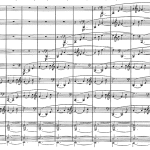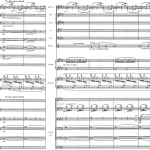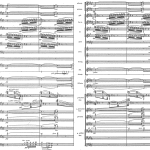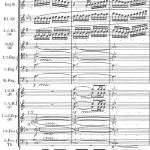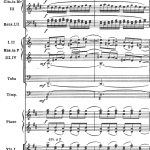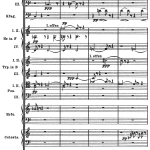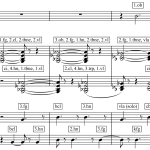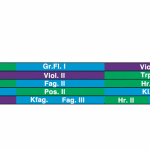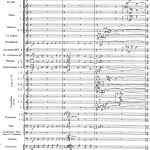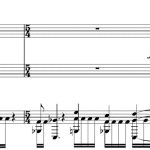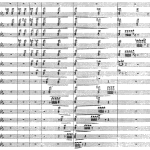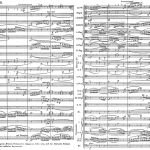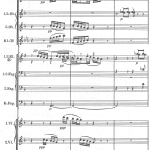In general terms, the designation “active harmony” will cover most traditional accompaniments, although chorale-like accompaniments do sometimes occur, primarily in music for the church.
In an orchestral context, active harmony may at times develop a life of its own. This can lead to brief or more extended independent harmonic segments – “accompaniment without melody,” as it were – or to accompaniments of such density and multi-layered complexity as to push the perception of melody aside.
A unique example in the history of orchestral music – an active field of harmony without true melody (background without foreground or vice versa?) – is the prelude to Wagner’s Das Rheingold (and in fact to the entire Ring Cycle). The horns’ broken triads create a stunning simultaneity of stasis and movement, in some ways reminiscent of the infinite glissando of the Shepard illusion (cf. Octaves, figure 41).
Figure 92 · Wagner, Das Rheingold, Vorspiel, m. 29
This example foreshadows the interest in “soundscapes without melody” or “tone-color melody,” found not only in the music of Debussy, but composers as different as Ravel, Stravinsky, Schoenberg, Rued Langgaard and Edgar Varèse.
In the music of Debussy, active harmony typically unfolds as an undulating vibration of sound, a harmonic background set into motion. At times this serves as a background for the melody, but not infrequently it either deemphasizes the hegemony of melodic elements (cf. the horn melody in La mer, 1st movement, number 5 or 3 m. before number 7), or takes over the musical texture altogether.
Figure 93 · Debussy, Iberia, “Les parfums de la nuit,” number 43
Figure 94 · Debussy, Iberia, “Les parfums de la nuit,” number 38
“Accompaniment without melody” would be a similarly appropriate designation for the two examples below. Freely formed scalar fragments and neighbor-note figures create a teeming but harmonically static field of sound similar to Wagner’s Vorspiel.
Figure 95 · Strauss, Till Eulenspiegel, m. 472
Figure 96 · Stravinskiy, Petrushka, number 167, m. 1
In “Farben” (opus 16, third movement), Schoenberg experiments with similar fields of sound without melody in any traditional sense of the word. The music consists primarily of a slow, sustained progression of chords in ever changing “split orchestration,” a representative example of Schoenberg’s Klangfarbenmelodie.
Figure 97 · Schönberg, Five Pieces for Orchestra op. 16, “Farben,” m. 13
Figur 98 · Schönberg, Five Pieces for Orchestra op. 16, “Farben,” m. 13, reduction
Schoenberg’s goal was to shift focus from motive to tone color. “There are no motives in this piece which have to be brought to the fore,” he wrote in his notes for the revised version of 1922.
The final chord of the movement exhibits a similar, deliberately “inhomogeneous” mix of colors: Schoenberg’s intention is not to merge instrumental timbres into a seamless entity, but to preserve their individual colors. Avoiding any doublings, the chord is orchestrated as a “split unison” with dynamics from pppp to pp in all the instruments, many of them in instrumental registers that pose a major challenge. The illustration below shows how the instrumentation changes continuously.
Figure 99 · Schoenberg, Five Pieces for Orchestra op. 16, “Farben,” final chord
In his music from the beginning of the 1920s, Edgar Varèse blurs the difference between melody and harmony to such an extent, that it becomes debatable whether such concepts still apply. In the example below, the melody could reasonably be described as “chordal” and the chord as “melodic.”
Figure 100 · Varèse, Arcana, m. 1
Figure 101 · Varèse, Arcana, m. 1, reduction
Segment 1 can be seen as a free parallel doubling (if not a melodic line in chords), segment 2 as a melody in “split orchestration.” But eventually the notes of segment 2 are sustained, and the melody actually transforms into a chord.
As the music of Varèse develops throughout the 1920s, musical line and momentum are increasingly supplanted by contrasts between different fields of sound. While the concept of melody and accompaniment disappears, rhythm takes over a leading role. The most essential feature of Varèse’s music becomes a paradoxical coexistence of stasis and movement, a limited number of musical elements in constantly transforming rotation. The analogy to theatre, backdrop and scenery, appropriate to traditional musical thinking, may here be replaced by the notion of a moving sound sculpture, a musical mobile.
Such fields of sound can also be found in the music of Danish composer Rued Langgaard, for example in the opening of his Music of the Spheres (1918). Despite the lack of an immediately apparent melody, it is clear that the diatonic clusterin the example below results from a descending and subsequently ascending melodic line whose single notes are sustained, technically similar to segment 2 in the Varèse example above.
Figure 102 · Langgaard, Music of the Spheres, p. 7
In the following example from Strauss, Don Quixote’s theme (in solo violin and oboe) has been woven into the fabric of undulating 16th notes (semiquavers), perceived as a mere shadow in the sound texture as a whole.
Figure 103 · Strauss, Don Quixote, Variation VIII, m. 1
In the example below it is hardly worth the trouble to contemplate whether the passage represents a displaced doubling or a diatonic field of five notes in motion.
Figure 104 · Strauss, Till Eulenspiegel, number 11
· · ·
Next · Chapter 7. Orchestral Idioms and Mass Effects after World War II
